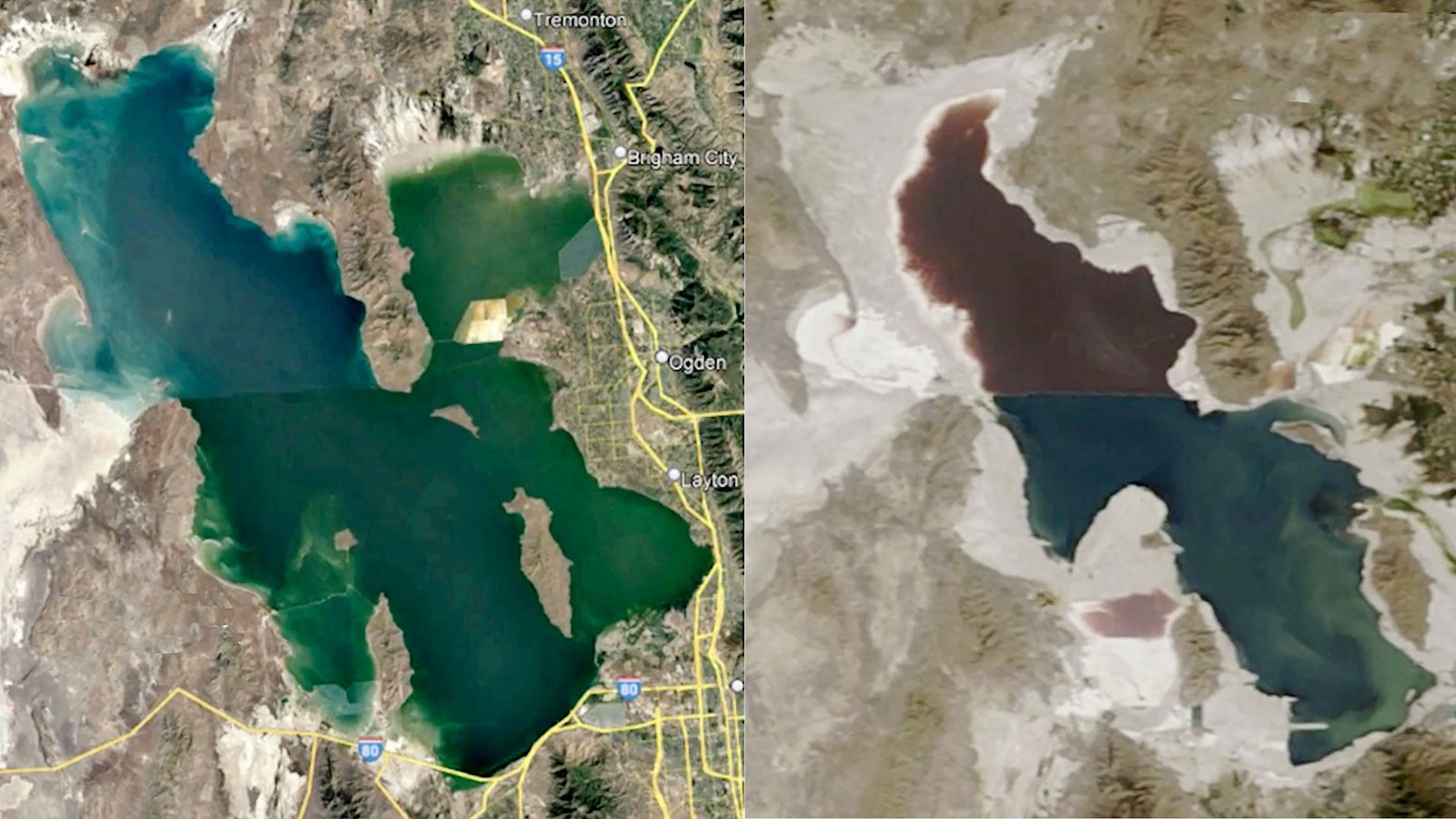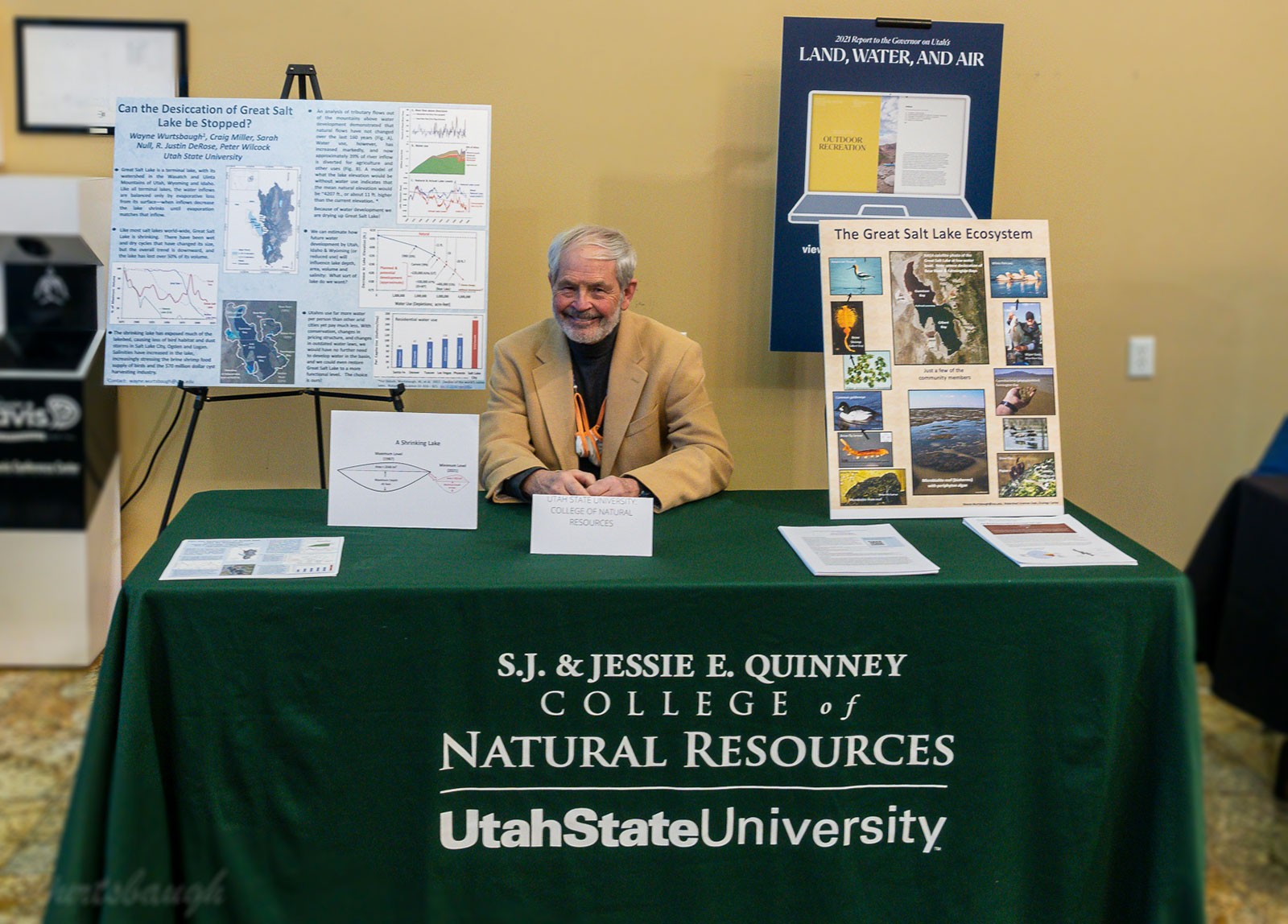A Lake in Peril: Researchers Participate in First Summit on Threats to the Great Salt Lake
By Lael Gilbert |
This composite of satellite images shows the receding Great Salt Lake. On the left is the lake at full capacity in December 1988, while on the right is the lake in September 2021 with 800 square miles of lakebed exposed. Water levels have reached record lows due to pressures from agricultural and municipal diversions, climate change and drought.
The iconic Great Salt Lake is in serious trouble, and lawmakers are noticing. Water levels in the lake have reached record lows due to pressures from agricultural and municipal diversions, climate change and drought. The shoreline contracted to an all-time low this year, exacerbating problems with air quality as dust from the exposed lakebed continues to sweep into the atmosphere, impacting health and seasonal snowpacks. Republican House Speaker Brad Wilson organized the first Great Salt Lake Summit this month, inviting experts from around the country, including researchers from Utah State University, to share strategies with lawmakers for resuscitating a lake in peril.
“The Great Salt Lake is reaching a tipping point,” said summit participant Wayne Wurtsbaugh from Watershed Sciences in the S. J. and Jessie E. Quinney College of Natural Resources. “Stakeholders from all areas — academics, industry and leadership — will need to come to the table and find consensus to address the complex problems it faces. This event was a good starting point for that kind of work.”
An analysis from the Utah Division of Water Resources and researchers at Utah State University showed that demands from agricultural, municipal sources and other water development projects have diverted 39% of the Great Salt Lake’s inflow, dropping the lake’s level by 11 feet. An ongoing 20-year drought has decreased water levels an additional 5.5 feet. Utah’s planned development of the lake’s major tributary, the Bear River, in addition to climate change and potential water development by Idaho and Wyoming threaten to decrease the water level even further.
Presenters at the summit said that solving the issues that contribute to record low lake levels will be difficult, but inaction could have devastating consequences affecting everything from human health to the state’s economy. The summit included lawmakers, researchers, environmental advocates and industry leaders from around the state.
As a terminal basin lake (one that doesn’t have an outlet to the sea), water levels in the lake are entirely determined by the amount of inflow, said Kevin Perry, atmospheric scientist from the University of Utah, citing research from Wurtsbaugh and his colleagues.
“We’ve been in deficit spending for the last twenty years or so, and the Great Salt Lake has been shrinking since,” Perry said. “Drought is contributing to our problems, but our water use policies are the bigger issue.”
Drying of saline lakes around the world costs billions of dollars in economic losses and mitigation efforts and causes severe harm to human health and the environment, adding up to impact potential costs as much as $1.7 to $2.2 billion per year in lost product extraction, recreation, costs for mitigation and health impacts, according to Don Leonard, chair of the Great Salt Lake Advisory Council.
“The lake has been in trouble for decades, suffering from heavy metals contamination, eutrophication, and particularly from the diversion of waters that sustain the ecosystem. Only recently have people started to be concerned, and the summit was a huge step forward in recognizing these problems,” Wurtsbaugh said.
Wayne Wurtsbaugh from watershed sciences in the S. J. and Jessie E. Quinney College of Natural Resources staffs a booth at the Great Salt Lake Summit on Jan. 5 in Layton, Utah. Wurtsbaugh, fellow USU researchers and experts from around the nation met at the summit to identify strategies to reverse the lake's desiccation.
WRITER
Lael Gilbert
Public Relations Specialist
Quinney College of Natural Resources
435-797-8455
lael.gilbert@usu.edu
CONTACT
Wayne Wurtsbaugh
Professor Emeritus
Watershed Science
wayne.wurtsbaugh@usu.edu
TOPICS
Environment 263stories Water 259stories Climate 151stories Conservation 82stories Air Quality 54stories Great Salt Lake 34storiesComments and questions regarding this article may be directed to the contact person listed on this page.









